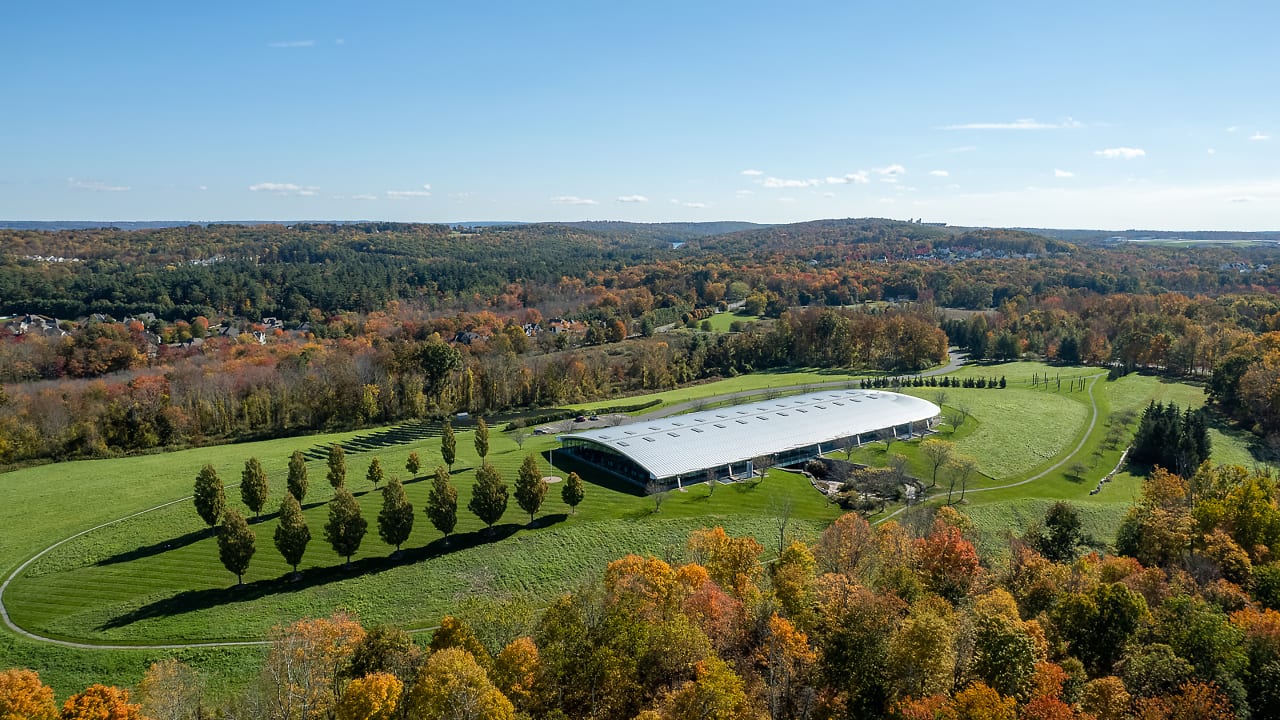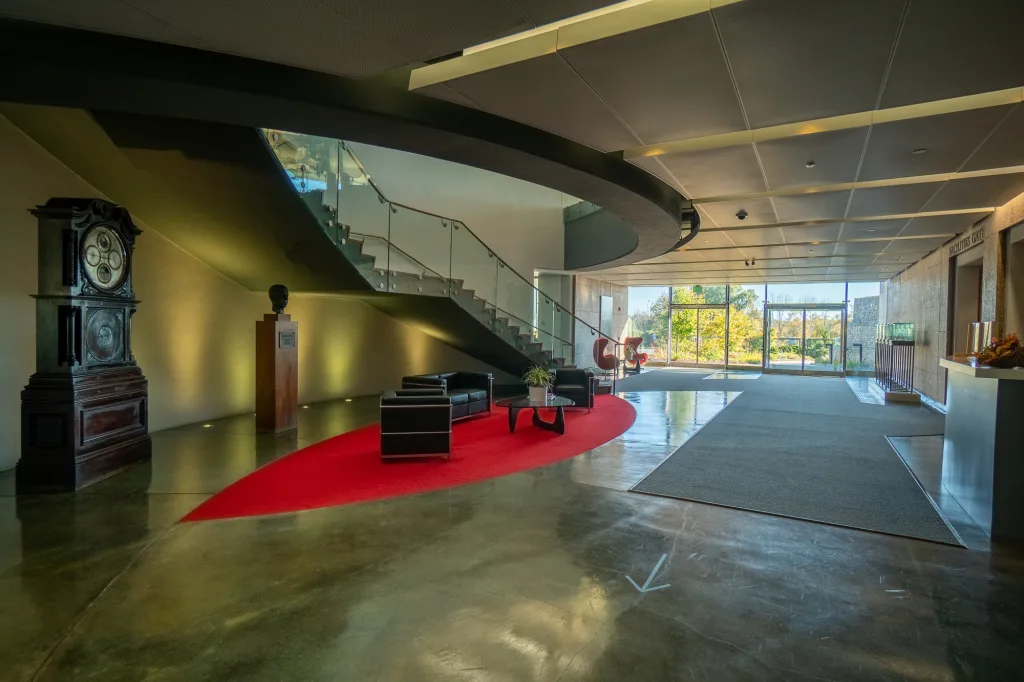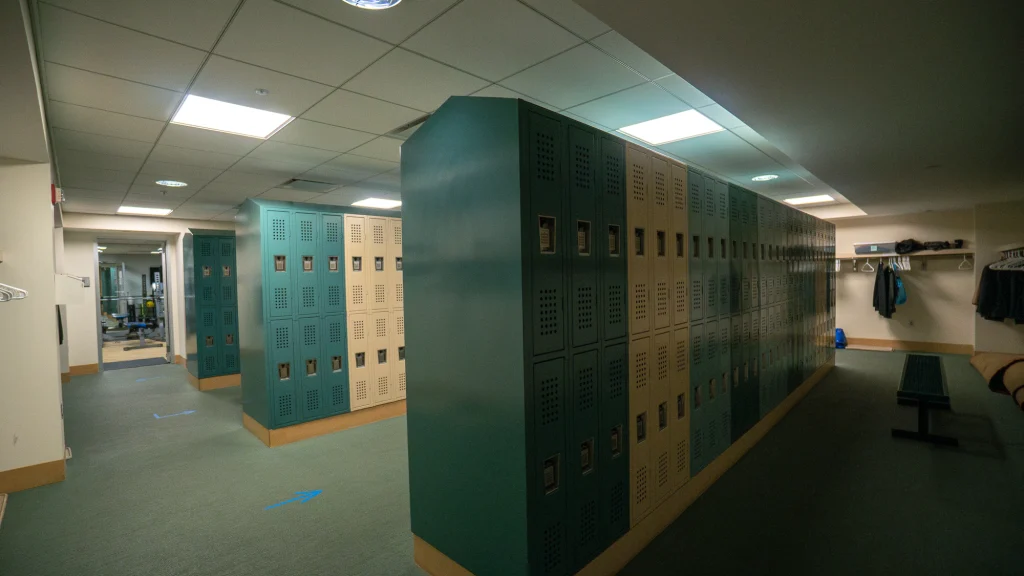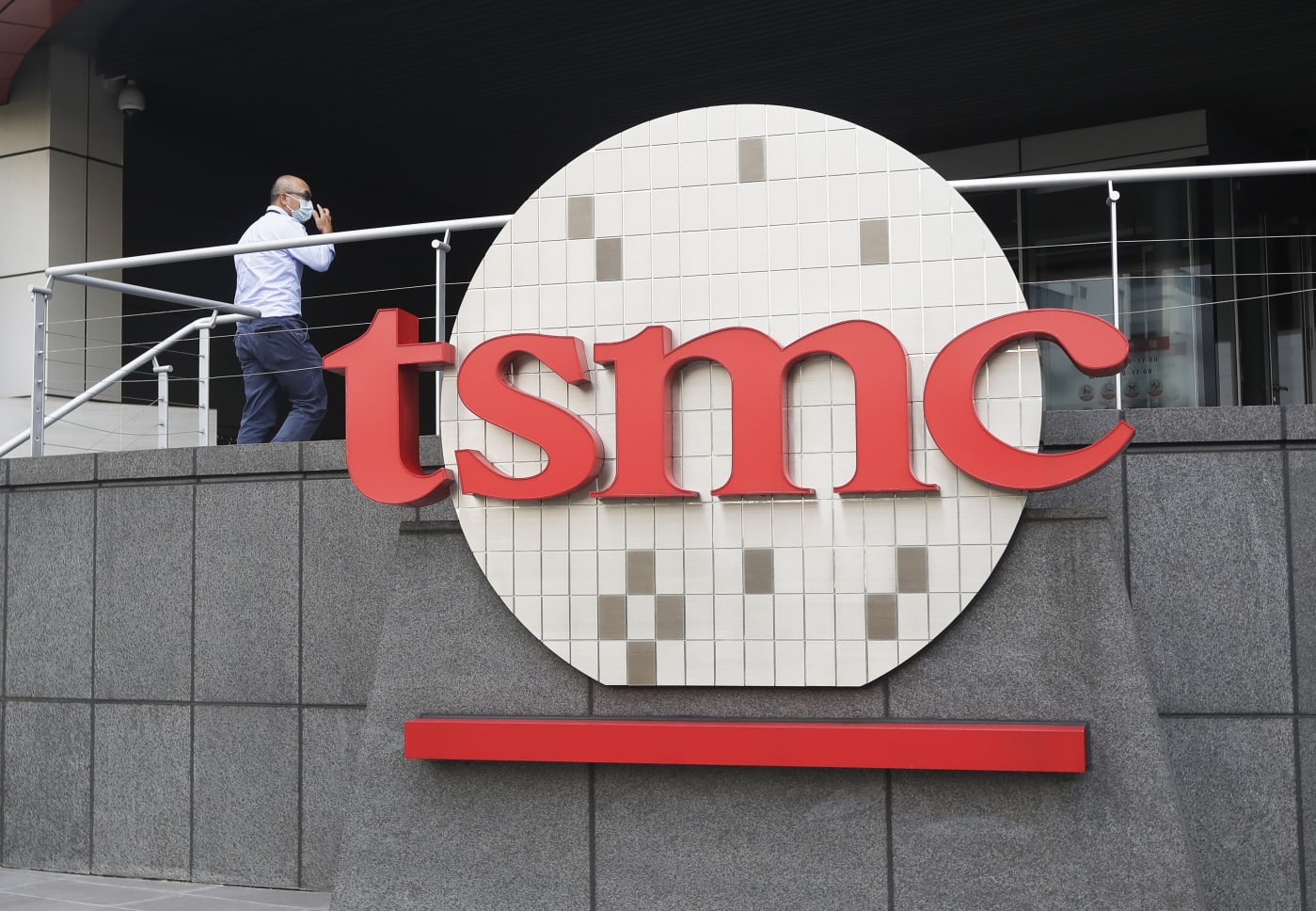The clock is ticking on Timex’s iconic Connecticut headquarters
When it opened in 2001, watchmaker Timex’s new headquarters building in Middlebury, Connecticut, was an architectural wonder. Its all-glass walls and open floor plan put the entire 275-person company in one big, light-filled workspace, covered by a swooping arched roof. It was a radical embrace of the ideals of openness, collaboration, and anti-hierarchical social interaction. On top of all this, the award-winning building had one additional—and unique—feature: a hole in the top that shines sunlight down on an ancient time-marking device known as a meridian line. Covering the building at the time, Fast Company noted “the building itself is a watch.” But now the building is on the verge of being demolished, decades earlier than most buildings of its generation would be threatened. A distribution center has been proposed for development on the site, and Timex, which is now majority owned by a hedge fund, is planning to move out. About the only thing standing in the way of the wrecking ball is a man named Nicholas Stuller. In 2020, the 61-year-old and his family moved to Middlebury, where he runs a financial technology startup. The town of about 8,000 people sits 25 miles outside of New Haven, and is mostly green and bucolic. It’s the kind of place where not much changes. So in 2023, many residents were surprised to learn of plans for a speculative 670,000-square-foot distribution center that a group of developers wanted to build there, not far from Interstate 84. Part of the complex, named Southford Park, would sit right on the footprint of the Timex building, known as Watch Hill. To build the distribution center, the Timex building would have to be torn down. [Photo: M3Media Productions] Stuller learned the news at the same time as the rest of the community, but he was even more in the dark: Still relatively new to the town, he didn’t know Timex was located there, or about its unique headquarters. Curious, he took a detour one morning in October 2023 on the way to dropping his daughter off at grade school. Stuller and his daughter pulled up to the building and walked in the front door to take a look. They ended up going on an impromptu tour led by a group of eager company employees. “They rolled out the red carpet. An hour and 15 minutes later, I had to take my daughter to school, but they kept on talking about the building, about the company,” Stuller says. “[It’s] a magnificent building,” he adds. “It’s so unusual. I’ve been in a lot of buildings around the country and the world, and this is a really unique building. I walked out of there saying, wow, something’s got to get done. Irrespective of the distribution center, this building needs to be preserved.” So Stuller launched a nonprofit called Save Historic Middlebury with the goal of creating preservation laws in the town, which currently has none. The intent is to establish the legal framework to stop the demolition of the Timex building. For now, there’s little to prevent the building’s owners from knocking it down. Save Historic Middlebury is trying to get the building recognized as a significant historic property. “It’s the only building, we think, in the world, let alone the U.S., where the building itself is a working example of the product the company makes,” Stuller says. His group has gathered support from a range of preservation groups, including the Sierra Club of Connecticut, the Cultural Landscape Foundation, and Docomomo US. [Photo: M3Media Productions] Former Timex employees are also supportive of the preservation effort. Lou Nugai worked in computer operations for Timex from 1968 until his retirement in 2012, spending time both in the company’s previous headquarters in an office park on the edge of town and in the current building from 2001 onward. “It was nice. The floor plan was open. There was good visibility. I liked it quite a bit,” he says, noting it was a particular improvement on the previous headquarters. “They were completely opposite. I wouldn’t say it was a dungeon, but it wasn’t as bright or cheerful as Watch Hill.” Last August Save Historic Middlebury made a formal application to the Connecticut State Historic Preservation Office to have the building added to the National Register of Historic Places. “When we applied to put the building on the register, not surprisingly the developer who owns the building said, ‘no, we don’t want you to put it on,’” Stuller says. But because anybody can apply for a building to be included on the National Register, Stuller and his group moved forward. In December, the application was denied at the state level, ostensibly because the building is not at least 50 years old, a general guideline often used to gauge a building’s historic character. “It’s one particular person at the state level who just doesn’t like new buildings,” Stuller says. Save Historic Middlebury is amending its application and plans to reapply. (The group also briefly filed a lawsui

When it opened in 2001, watchmaker Timex’s new headquarters building in Middlebury, Connecticut, was an architectural wonder. Its all-glass walls and open floor plan put the entire 275-person company in one big, light-filled workspace, covered by a swooping arched roof. It was a radical embrace of the ideals of openness, collaboration, and anti-hierarchical social interaction. On top of all this, the award-winning building had one additional—and unique—feature: a hole in the top that shines sunlight down on an ancient time-marking device known as a meridian line. Covering the building at the time, Fast Company noted “the building itself is a watch.”
But now the building is on the verge of being demolished, decades earlier than most buildings of its generation would be threatened. A distribution center has been proposed for development on the site, and Timex, which is now majority owned by a hedge fund, is planning to move out. About the only thing standing in the way of the wrecking ball is a man named Nicholas Stuller.
In 2020, the 61-year-old and his family moved to Middlebury, where he runs a financial technology startup. The town of about 8,000 people sits 25 miles outside of New Haven, and is mostly green and bucolic. It’s the kind of place where not much changes. So in 2023, many residents were surprised to learn of plans for a speculative 670,000-square-foot distribution center that a group of developers wanted to build there, not far from Interstate 84. Part of the complex, named Southford Park, would sit right on the footprint of the Timex building, known as Watch Hill. To build the distribution center, the Timex building would have to be torn down.

Stuller learned the news at the same time as the rest of the community, but he was even more in the dark: Still relatively new to the town, he didn’t know Timex was located there, or about its unique headquarters. Curious, he took a detour one morning in October 2023 on the way to dropping his daughter off at grade school.
Stuller and his daughter pulled up to the building and walked in the front door to take a look. They ended up going on an impromptu tour led by a group of eager company employees. “They rolled out the red carpet. An hour and 15 minutes later, I had to take my daughter to school, but they kept on talking about the building, about the company,” Stuller says.
“[It’s] a magnificent building,” he adds. “It’s so unusual. I’ve been in a lot of buildings around the country and the world, and this is a really unique building. I walked out of there saying, wow, something’s got to get done. Irrespective of the distribution center, this building needs to be preserved.”
So Stuller launched a nonprofit called Save Historic Middlebury with the goal of creating preservation laws in the town, which currently has none. The intent is to establish the legal framework to stop the demolition of the Timex building. For now, there’s little to prevent the building’s owners from knocking it down.
Save Historic Middlebury is trying to get the building recognized as a significant historic property. “It’s the only building, we think, in the world, let alone the U.S., where the building itself is a working example of the product the company makes,” Stuller says. His group has gathered support from a range of preservation groups, including the Sierra Club of Connecticut, the Cultural Landscape Foundation, and Docomomo US.

Former Timex employees are also supportive of the preservation effort. Lou Nugai worked in computer operations for Timex from 1968 until his retirement in 2012, spending time both in the company’s previous headquarters in an office park on the edge of town and in the current building from 2001 onward.
“It was nice. The floor plan was open. There was good visibility. I liked it quite a bit,” he says, noting it was a particular improvement on the previous headquarters. “They were completely opposite. I wouldn’t say it was a dungeon, but it wasn’t as bright or cheerful as Watch Hill.”
Last August Save Historic Middlebury made a formal application to the Connecticut State Historic Preservation Office to have the building added to the National Register of Historic Places. “When we applied to put the building on the register, not surprisingly the developer who owns the building said, ‘no, we don’t want you to put it on,’” Stuller says. But because anybody can apply for a building to be included on the National Register, Stuller and his group moved forward.
In December, the application was denied at the state level, ostensibly because the building is not at least 50 years old, a general guideline often used to gauge a building’s historic character. “It’s one particular person at the state level who just doesn’t like new buildings,” Stuller says. Save Historic Middlebury is amending its application and plans to reapply. (The group also briefly filed a lawsuit under the Connecticut Environmental Policy Act to stave off demolition, but withdrew the suit in December.)
Timex plans to vacate the building this spring and move into another office building in nearby Shelton. “Once it’s vacant, theoretically the property developer could knock it down,” Stuller says. Timex did not respond to requests for comment.

In the meantime, other groups in Middlebury have lobbied to stop the development project that would result in the Timex building’s demolition. The Middlebury Small Town Alliance has led a lawsuit against the distribution center’s developers.
“It doesn’t match our community,” says Jennifer Mahr, president of the alliance. Her organization is opposed to the distribution center, but is also in favor of preserving the Timex building. “A lot of us agree that something else could be done on that property as is,” says Mahr, who was subsequently elected to the town’s governing Board of Selectmen. “It’s a perfectly fine building.”
In January, the group got a favorable ruling from the local superior court judge, who decided that permits issued to the developers were in violation of the town’s wetlands and zoning regulations, effectively halting the project. But an appeal is now being prepared. Lawyers for the developer declined to comment.
“I’ll be surprised if the appellate court takes the case,” Mahr says. “I do think that their appeal has run out of steam.”
Even if the distribution center project falls through, Stuller and his group of volunteer preservationists are concerned that the Timex building is still in danger. He says the group plans to filed its amended National Register application directly to the National Park Service within the next month or two. They’re hoping for a positive response the second time around, but aren’t relying on protection from the top down.
Stuller says the building’s fate may hinge on how much support he can gather from the local community and beyond. “Once we continue to beat this drum and get the word out,” he says, “I think there’s decent odds we can convince the people that do control the building to change their plans.”

































































































































































































![How to Find Low-Competition Keywords with Semrush [Super Easy]](https://static.semrush.com/blog/uploads/media/73/62/7362f16fb9e460b6d58ccc09b4a048b6/how-to-find-low-competition-keywords-sm.png)
